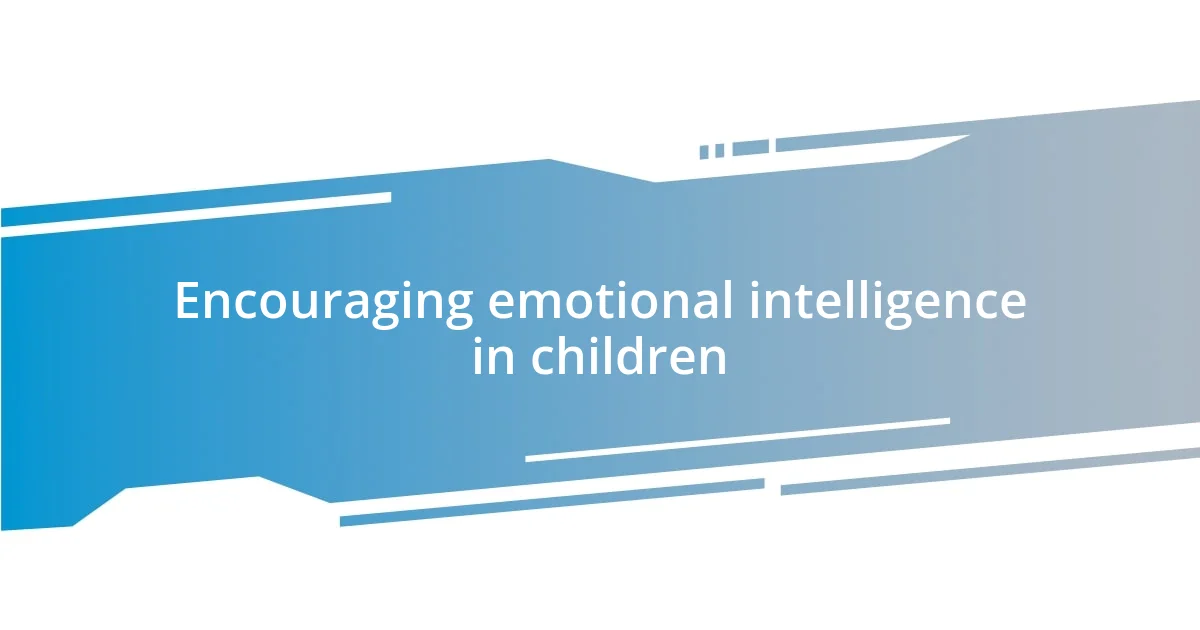Key takeaways:
- Gentle parenting emphasizes empathy, respect, and understanding, fostering a stronger emotional connection and open communication between parents and children.
- Effective communication strategies, such as active listening and feelings validation, enhance mutual understanding and create a nurturing home environment.
- Setting boundaries with empathy encourages responsibility and cooperation, transforming potential conflicts into learning opportunities for children.

Understanding gentle parenting principles
Gentle parenting revolves around three core principles: empathy, respect, and understanding. When I first embraced this approach, I realized how pivotal it is to see things from my child’s perspective. Have you ever noticed how their little frustrations can feel as monumental to them as any adult crisis? By honoring their feelings, I found that my responses shifted from frustration to compassion.
Another essential principle is maintaining open communication. I recall a moment when my child was upset about a minor issue, and instead of brushing it aside, I took the time to listen. It may seem small, but that experience taught me the value of active listening. Instead of simply hearing my child, I engaged with their emotions, reinforcing our bond and fostering trust. When was the last time you genuinely listened to someone without an agenda?
Lastly, gentle parenting promotes discipline through guidance rather than punishment. I’ve come to understand that mistakes are opportunities for learning rather than occasions for reprimanding. For instance, when my child spilled juice all over the table, instead of reacting with annoyance, I calmly discussed how to manage spills in the future. This gentle approach not only prevented a power struggle but also taught them accountability. Isn’t it rewarding to witness a child learn from their actions in a supportive environment?

Key benefits of gentle parenting
One key benefit of gentle parenting is the strengthened emotional connection it fosters between parent and child. I’ve experienced a remarkable change in the way my child and I interact. By practicing empathy, not only do I see my child’s feelings more clearly, but I also feel their trust grow. It’s an incredible feeling when my child openly shares their worries, knowing they’re met with understanding instead of judgment.
Here are some additional benefits I’ve observed:
– Enhanced emotional intelligence: Children learn to identify and express their feelings.
– Improved behavior: With guidance rather than punishment, children are more likely to cooperate.
– Stronger problem-solving skills: They learn to navigate challenges through discussion, cultivating independence.
– Lower stress levels: A gentle approach reduces anxiety, making our home more peaceful.
– Increased resilience: Kids develop the ability to cope with setbacks positively.
These benefits have made a profound difference in our daily life, transforming moments that could have led to conflict into opportunities for growth and connection.

Effective communication strategies in parenting
Effective communication is crucial in gentle parenting, as it bridges the gap between understanding and action. I once witnessed a significant transformation during a routine bedtime struggle. Instead of just insisting my child go to bed, I asked what they were feeling. Their response was an outpouring of fears about the darkness and what might be lurking in the shadows. By addressing their concerns with empathy, we established a bedtime ritual that included a nightlight and a few minutes of sharing stories, transforming bedtime from a battle into a comforting experience.
Another strategy I’ve found immensely valuable involves validating my child’s feelings before responding. There was one instance when my little one was devastated about losing a favorite toy. Instead of downplaying their disappointment, I acknowledged their sadness and shared when I felt similarly about losing something important to me. This sharing not only validated their feelings but opened up a heartfelt conversation that deepened our bond. It’s amazing how a simple acknowledgment can lead to meaningful dialogue and connection, don’t you think?
| Communication Strategy | Description |
|---|---|
| Active Listening | Fully engaging with your child’s emotions and concerns, responding thoughtfully. |
| Feelings Validation | Acknowledging and empathizing with your child’s emotions to encourage openness. |
| Story Sharing | Using personal anecdotes to create a relatable connection and foster dialogue. |

Creating a nurturing home environment
Creating a nurturing home environment is about more than just physical space; it’s about cultivating a feeling of safety and belonging. I remember transitioning our living room into a calm, cozy space where we could unwind together as a family. I invested in soft cushions, soothing colors, and meaningful decorations that reflect our family’s shared experiences, making it a haven for laughter and connection. Have you ever noticed how a warm environment encourages open conversations?
Another crucial element is consistency in our routines, which brings a sense of stability for my children. For instance, we established a designated family dinner time that serves as an opportunity for everyone to share their day. This practice not only fosters communication but also instills a sense of togetherness that my children look forward to. I truly believe that predictable moments create a comforting rhythm in our daily lives.
Additionally, I find that offering choices empowers my kids and nurtures their independence. For example, letting them decide between two different healthy snacks helps them feel valued, fostering their confidence while still promoting good habits. It’s interesting how empowering children to make small decisions creates a nurturing atmosphere where they feel they have a say and are respected. Doesn’t it fill you with joy to see your child take pride in their choices?

Setting boundaries with empathy
Setting boundaries with empathy means recognizing the emotional landscape of our children’s experiences while guiding them toward appropriate behavior. I vividly remember a moment when my son struggled with sharing his toys during playdates. Instead of scolding him, I knelt down to his level and asked why he felt hesitant to share. His eyes widened as he confessed that he feared losing his favorite truck. This simple conversation allowed us to come up with a compromise where he could set aside his most cherished toy while keeping others in circulation. It transformed a typical playdate into an empowering lesson on sharing through understanding.
When boundaries are communicated with compassion, children feel seen and heard. One time, my daughter insisted on staying up late for a book she was engrossed in. Rather than just saying no, I reflected her passion by discussing the importance of sleep while still validating her desire to finish the story. We struck a deal: she could read for fifteen more minutes, and then we would read together in the morning. This approach not only upheld the boundary but also fostered a sense of responsibility in her, showing that her feelings mattered and could contribute to a larger conversation about expectations.
Establishing boundaries doesn’t have to feel like a power struggle. I’ve learned that framing them within the context of mutual respect and understanding creates a more harmonious atmosphere. During a particularly hectic week, my children were pushing limits, and I felt overwhelmed. Instead of reacting out of frustration, I gathered them and shared how much I valued our time together, explaining why I needed their cooperation with specific rules, like screen time limits. This dialogue transformed their initial resistance into camaraderie, as they understood my perspective and even offered solutions. Isn’t it incredible how children can rise to the occasion when we show them the grace of empathy?

Encouraging emotional intelligence in children
Encouraging emotional intelligence in children is all about helping them understand their feelings and those of others. I’ve found that discussing emotions openly can significantly impact my kids’ ability to navigate their feelings. One evening, we were watching a movie, and I noticed my daughter tearing up during a touching scene. Instead of quickly brushing it off, I turned to her and asked how she felt about it. This simple act opened up a heartfelt discussion about empathy and emotions, allowing her to articulate her feelings and gain a deeper understanding of emotional responses.
Another effective way to nurture emotional intelligence is through storytelling. I often read books with my children that tackle various emotional situations, like friendship struggles or feelings of disappointment. After reading, we engage in discussions about the characters and their choices. Reflecting on these scenarios allows my kids to relate their experiences to the stories and helps them practice empathy in a safe environment. Doesn’t it impress you how literature can be such a powerful conduit for understanding emotions?
I also make it a point to model emotional expression myself. When I experience stress or happiness, I share my feelings with my children in age-appropriate ways. For instance, during a tough day, I’ve been open about feeling overwhelmed, but I also emphasize self-care strategies I use to manage it. This transparency not only teaches them that it’s okay to express emotions but also equips them with tools for emotional regulation. How wonderful is it to see our children learn that vulnerability can lead to strength?
















